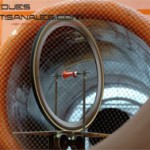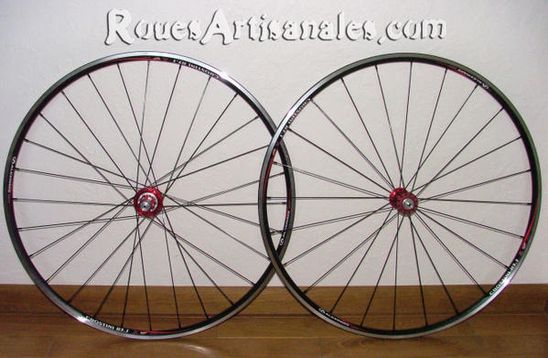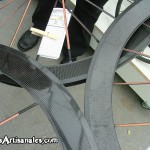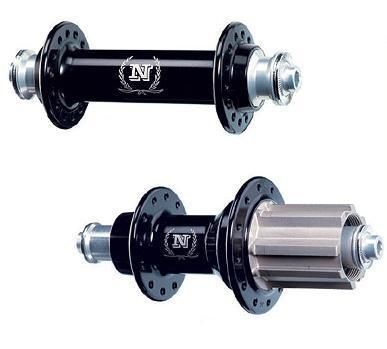Link great wheel test 2008 version
The last year in August we were glad to analyse the wheels test performed by the german magasine called TOUR. This year, they have done it again with some
other models. The protocol is similar to assure the tests reproductibility. An important data base is available and we propose it here.
Tests criterions:
Aérodynamism: Ability of a wheel to penetrate the airflow. The lowest this number is, the better is the wheel. The unit is the Watt. In the test,
the watts absorbed at 30, 40 et 50km/h are given. We will only use the figure at 50km/h.
Inertia: Ability of the wheel to keep its speed. The lowest the value, the easier is the wheel to change its speed (acceleration or deceleration).
On the other hand, the higher the value, the longer the wheel keeps its speed. The inertia directly translates the behaviour of the wheels, it’s a more important value than the weight itself. The
unit is the Joule in this test but normaly the gr/mm², see the measure protocol to know more.
Lateral stiffness: Ability of the wheel to lateraly move under strain. The highest the value, the less flexy is the wheel under your pedal stroke
and while cornering. So it translates the stiffness of the wheel and how much it will flex when the wheel won’t be perpendicular to the ground. The unit is the N/mm.
Weight limit: Maximal user weight for a safe use. Over this limit, one should contact the manufacturer to know if the wheels can be used because it
may be dangerous.
Protocols:
Aerodynamism test: The test was performed at the Technical University of Lyon. The open windtunnel design has been optimized for wheel testing by
Mavic. Only front wheels are tested. Wind speed is 50km/h. The wind and drive forces of the belt driven wheel is measured. Using this method both aero drag and drag that’s caused by the rotating
wheel itself can be measured. The aero drag is tested at several angles by turning the wheel away from the wind direction between 0 to 15 degrees. The testing procedure is fully automated. In every
position 3 test values are taken which have to correlate closely to each other for the test to be valid. The curve only represents data taken from a single speed.
Inertia test: The wheel is hung up with a magnet at the bottom. They then swing it and the tachometer at the bottom measures the period duration.
They repeat the test 3 times. Then, calculate the energy required to accelerate the front and rear wheelset including tires to 30km/h. (see this page)
Lateral stiffness test: Wheel is fixated with a skewer to their testing equipment. A line is tied to the rim between the spokes. The force necessary
to deflect/pull the wheel sideways and the resulting amount of movement are registered by computer. The resulting value is N/mm and it take from both front and rear wheel.
2005 and 2006 results by alphabetical order:
|
Model
|
Aero (W)
|
Inertia (J)
|
Lateral stiffness front / rear
(N/mm²)
|
Weight limit
(Kg)
|
|
Ambrosio X-Carbo
|
31,5
|
114
|
65 / 40
|
90
|
|
Bontrager Race X Lite Carbon aero
|
23,4
|
105
|
67 / 44
|
no limit
|
|
Campagnolo Eurus
|
27,8
|
123
|
61 / 58
|
82
|
|
Campagnolo Hyperon
|
32,1
|
97
|
55 / 53
|
82
|
|
Campagnolo Bora G3
|
23
|
103
|
53 / 44
|
82
|
|
Citec 3000S
|
30,6
|
127
|
57 / 56
|
99
|
|
Citec 3000S Aero
|
25,5
|
129
|
55 / 56
|
89
|
|
CKT Splendor
|
21,7
|
115
|
64 / 54
|
110
|
|
Corima Aero
|
24,7
|
106
|
65 / 38
|
no limit
|
|
Corima Turbospoke
|
23,1
|
111
|
34 / 34
|
no limit
|
|
Easton Tempest II Carbon
|
21,6
|
101
|
61 / 46
|
no limit
|
|
FRM FL-R 23 SD Aerolight
|
24,6
|
105
|
53 / 32
|
no limit
|
|
FSA RD-600
|
28,7
|
124
|
40 / 33
|
no limit
|
|
Fulcrum Racing Speed
|
23,7
|
102
|
55 / 42
|
no limit
|
|
Gipiemme Carbon 5-5
|
24,1
|
148
|
68 / 40
|
120
|
|
HED Hed 3
|
19,7
|
129
|
36 / 35
|
100
|
|
Lightweight Obermayer
|
24,8
|
84
|
78 / 57
|
80
|
|
Lightweight Ventoux/Standard
|
27,3
|
88
|
55 / 50
|
no limit
|
|
Mavic Aksium Race
|
30,0
|
143
|
74 / 48
|
no limit
|
|
Mavic Ksyrium ES
|
33,2
|
120
|
56 / 47
|
no limit
|
|
Mavic Cosmic Carbone SL
|
21,9
|
143
|
59 / 53
|
100
|
|
Ritchey WCS Carbon
|
19,3
|
97
|
37 / 32
|
no limit
|
|
Rose Aerospoke
|
23,0
|
165
|
33 / 29
|
no limit
|
|
Shimano WH-7801 Carbon 50
|
22,9
|
110
|
78 / 51
|
no limit
|
|
Shimano WH-7801 Carbon
|
24,4
|
98
|
64 / 51
|
no limit
|
|
Shimano WH-R560
|
26,1
|
132
|
58 / 48
|
no limit
|
|
Tune Olympic Gold 2005
|
24,1
|
88
|
37 / 33
|
90
|
|
Tune Skyline 2006
|
28,1
|
78
|
42 / 28
|
85
|
|
Vuelta Carbon Pro WR
|
20,8
|
108
|
46 / 30
|
100
|
|
Xentis Mark 1
|
25
|
103
|
40 / 37
|
no limit
|
|
Zipp 808
|
18,1
|
107
|
53 / 41
|
no limit
|
Graphs of the results:
Aerodynamism; front wheels ranked from the fastest to the slowest. The wind is 0°.
Click to enlarge
The Zipp 808 tested the last year are still the fastest of this comparative. It will be hard to beat it, the 82mm dimpled deep rim is very efficient. The Ritchey and Easton are close, they use the
old Zipp 404 rims without the dimples. They are very good too. The special 3 spokes HED and the Vuelta are at the front of the first pack while the Corima Turbospoke (3 spokes) and the Rose
Aerospoke (4 spokes) are a little slow compared to some conventionnal wheels like Mavic Cosmic Carbone, Shimano Carbon 50mm or Campagnolo Bora G3. It shows that a conventionnal wheel well designed
can be faster than a time-trial specific wheel.
The Ksyrium ES are very bad compared to the peloton. The thick spokes and the flat machinned rim isn’t a good combo.
As a whole, on this graph the deep rims are obviously leading. They are followed by some wheels we could qualify as « transitory » such as the Citec 3000S aero to the FSA RD-600. Then the wheels non
designed for the speed are at the bottom of the rank.
As information, a standard wheel with a flat rim and 36 round spokes absorbs 48W at 50km/h.
Inertia; wheels ranked from the easiest to change its speed to the hardest.
The weight of the rim is here what is going to have the most influence on the inertia of the rim. Thus, the Tune Skyline based upon Reynolds KOM rims, Cx-ray spokes and Mig45&Mag140
(1, 2, 3, 4) are on the highest place of the podium, a little before the
Lightweight Obermayer tested in 2005. The Tune Olympic Gold used the very light X-treme high profile (45mm) rims and so they are obviously on the podium as well. It’s a draw with the combo
Lightweight Ventoux/Standard (low profile rim at the front and deep
profile rear rim).
These four sets are far in front of the principal peloton closed by the Shimano WH-R560. The following wheels are far from this pack because of their heaviness. They will be prefect for
cruising.
Stiffness; front then rear wheels ranked according to their lateral rigidity properties from the stiffest to the
flexiest.
Click to enlarge
First of all, carbon spoked wheels are pretty flexy, the HED 3, Corima Turbospoke and Rose are far from the head. A lot of thin spokes is stiffer than a couple of big spokes.
High profile wheels are at the top of this rank even through there are some exceptions as the ones using light hubs or low bracing angle on the non drive side. For example Ritchey, FRM, Tune
Olympic Gold. The low spoke count is not really the problem because the Easton, with only 18 and 20 spokes are very stiff (16/24 for the Ritchey and 18/24 for the Tune). It proves that the wheel
build or the design of the hub has a great influence on the overall stiffness of the wheel and can compensate for a low spoke count. The perfect example is the rear Campagnolo Bora G3: a low non
drive side spokes count (8) but the bracing angle is very important and so the stiffness is not that bad. The Eurus using a similar pattern is pretty good too.
Last important point about the Shimano Carbone (flat and deep rims), they are very stiff. The spoke count is very low (16/20) but the drive side radial pattern and non drive side crossed pattern
(the same as the IsoPulse system from mavic) gives a good spoke tension balance and beside this a good stiffness. It seems Shimano has pushed further this mavic design since Shimano wheels
stiffness is higher than the Ksyrium ES. They certainly use stiff carbon rims as well.
Quick remark about the Obermayer tested the last year: the rear wheel stiffness wans’t good because a pre-production version had been tested. The current versions reach 57 to 60N/mm for the rear
wheel (instead of 37N/mm the last year for the pre-production version and 50N/mm for the Standard). So the Tune carbon axle is not bad but stiff.
Interpretations
Like the last year, here are some ratio that will show the ability of the wheels for differents use.
The ratio are not fully representative of the reality, it gives an idea on how good a wheel can be for an application.
In first, the moment of inertia/aerodynamism ratio will show the ability of the wheels to suit for high speed cruising rides or time-trials with no regular
accelerations. The high moment of inertia will keep the speed while the aerodynamism has to be the best as possible to reduce the drag.
Click to enlarge
There is no big surprise here since the high profile wheels and (relatively) heavy are at the top while light wheels are doubly disadvantaged for
these exercises because most of them are flat.
The two first positions are taken by carbon spoked wheels (4 and 3 spokes) while the well known Mavic Cosmic Carbone is very close.
Some low/medium profile wheels as the Citec 3000S Aero or the Shimano R560 are in the first half thanks to the high inertia and relatively good aero combo.
Then the stiffness/moment of inertia ratio will translate the ability of the wheel to climb or accelerate. In mountain or hill, while accelerating after a
corner or in the peloton, the cyclist stands on the bike from the left to the right transmitting an important and irregular torque. Therefore he needs stiffness and low inertia to be the least
tired.
You will find here, both front and rear wheel graphs ranked from the best wheel to climb to the worst one of this comparative.
Click to enlarge
Carbon wheels are at the top of the cobble. The Lightweight Obermayer are unbeaten, very stiff and very light, they easily win the uphill race. Shimano wheels are excellent as well and the deep
front wheel is even better to climb (theorically) than its little sister with flat rims (should be verified in real conditions though). No huge surprise here either even through the Tune Skyline
2006 are disappointing although they have the lowest moment of inertia.
It seems lightness and stiffness are rarely associated.
Click to enlarge
As for the front wheels, rear wheel rank follow a similar outline. Carbon in first and TT or medium range wheels at the bottom. It seems there are two intruders in the first places: the Campagnolo
Eurus and the CKT Splendor.
We spoke in ’05 about the Reynolds KOM or the Zipp 250 which should take the first places in such a table. This is finally not the case since the TUNE Skyline 2006 using Reynolds KOM rims can’t
even reach half the table. They will anyway be very easy to use in mountain whether the rider is very light or accelerate smoothly.
Conclusion
From the tests, a wheelset seems to be overall better than the others. It is the Shimano WH-7801 Carbon 50mm. A good aero, an excellent stiffness and a medium inertia, here are the characteristics
of this versatile wheelset that should get much more attention. We can notice many sets destinated to the mountain or the criteriums such as the Campagnolo Hyperon, the Lightweight Obermayer or the
Ventoux/standard, the Shimano Carbon…
Of course some others sets differ from the others thanks to their qualities in the differents domains. We let you make your own opinion about the wheels we didn’t speak about.
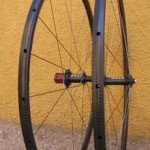

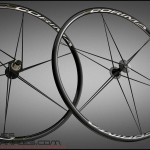
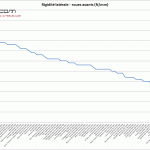
 Photo by Alessandro Trovati
Photo by Alessandro Trovati









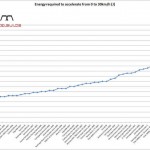
 Photo credit : www.photos-dauphine.com
Photo credit : www.photos-dauphine.com